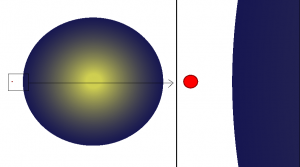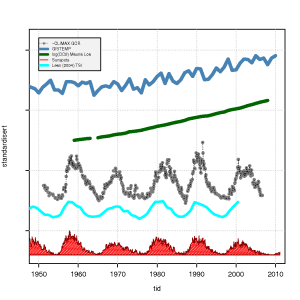New results from the University of Aarhus in Denmark and the Danish National Space Institute allegedly show that particles from space create cloud cover, according to a recent press release. And the Physics World magazine (May, 2011) report that the
researchers say this is the best experimental evidence yet that the Sun influences the climate by altering the intensity of the cosmic-ray flux reaching the Earth’s surface.
Quite spectacular claims! So let’s see what is the source of this information.
The basis for the statements was a recent paper published in GRL by Enghoff et al. The key points in the paper are stated as: (a) Cosmic rays increase nucleation rate, (b) A particle beam is not needed, for experiments, and (c) Ions are important for atmospheric nucleation rate. But where is the link to real clouds?
The word ‘cloud’ is mentioned in the paper. In the introduction:
Aerosol and cloud research is one of the most critical frontiers of climate science [Shindell et al., 2009; Bodenschatz et al., 2010] and the direct radiative forcing and indirect cloud albedo forcing from aerosols remain the dominant uncertainty in the radiative forcing of the atmosphere
The word ‘cloud’ is also found in some of the titles of the publications in the citation list. And that’s it.
OK, so this study is really about a laboratory experiment. The results presented are of the impact of ionization on the formation rate of aerosols with size ~4 nanometers (nm), as shown in the figure below:

Enghoff et al claim that the figure shows a clear contribution from ion-induced nucleation and considers this to be the (quoted from the paper’s abstract)
first unambiguous observation of the ion-effect on aerosol nucleation using a particle beam under conditions that resemble the Earth’s atmosphere.
Not so fast!
There is a significant amount of aerosol formation taking place with no ionization (“background levels”), and when the sample air in the experiment was replaced, this caused a large jump (seen as a shift along the vertical axis) in the formation rate (the different colours in the figure above). This clearly shows that the formation rate is also highly sensitive to factors other than ionization.
The figure further shows that the relationship between the ionization and the aerosol formation is not all that strong. There is a relationship, but there is substantial scatter and the slopes of the best fit are not very steep.
So let’s look at the clouds data. Is there a clear 11-year cycle in the cloud cover? The figure below presents the global low cloud cover from the ISCCP project. Perhaps there is an 11-year cycle embedded in the evolution since 1983, perhaps not. However, the variations in the evolution are clearly not dominated by 11-year cycles.

We see the same thing in a study by Harrison & Stephenson (2006), which provides an additional clue based on diffuse light, which is light scattered by clouds. They do find a link between cosmic galactic rays (GCR) and the diffuse light (figure below), suggesting a link between the GCR and cloudiness. But when you look at the scatter plot, the link is not very visible (if you ignore the fitted lines). The reason for this is that this link is very weak.

There has been a number of studies on the relationship between solar activity and earth’s climate, suggesting there is a solar signal. But the solar influence seems to be weak. GCR don’t come from the sun, but are charged particles from distant galaxies and stars that are modulated by the solar magnetic field. The solar magnetic field is closely linked to solar activity.
Figure 1 here may be consistent with a weak relationship between GCR and clouds, due to a substantial scatter, weak trend (not very steep slope), and the pronounced effect of changing the air supply.
It is conceivable that turbulent mixing of the air will produce small pockets of air with higher formation rates, in a same fashion as air with different impurities did in the experiments of Enghoff et al.
However, there is another reason why there really is a weak link from Enghoff et al.’s results to clouds. The experiment conducted by Enghoff et al. examined the formation of ultra-fine aerosols with size of 4 nanometers. But clouds need particles of the size approximately 10000 nanometers (10 micrometers) to form cloud drops for air that is barely supersaturated, according to the Köhler curve (which is central to cloud micro-physics).
What happens between the stage where 4nm aerosols form and the stage where they becomeact as CCNcloud drops (with a ~10 micrometer radius) is unknown (see Figure 4 for a depiction of these two stages). The aerosols must grow and become an order of million times larger in terms of their initial volume.

It is interesting to note the way the word “climate” appears in the GRL paper (3 times: once in the introduction and twice in the titles in the reference list) and the Danish press release (15 times, counting phrases such as ‘climate chamber’ and ‘climate researcher’). The press release claims that the results
substantiate the connection between the Sun’s magnetic activity and the Earth’s climate
and that
there is much to indicate that climate models must hereby take cosmic radiation into consideration.
It is difficult to explain any long-term change in our climate in terms of the hypothesis that GCR affect clouds, having an effect on the albedo, and ultimately the temperatures. For starters, we see no evidence for any long-term change in the sun in the last 50 years (light blue and red curves in Figure 5 below) or in the GCR measurements (grey symbols in Figure 5).

So my take on this, is that the paper only really shows that the nature of the ionizing particles is not important for the ion-induced component of the nucleation. Does this imply that the cloud experiment at CERN is necessary? I wonder. But key point (c), that
ions are important for atmospheric nucleation rate
is not supported by the evidence presented in the paper. Ions play a role, but Figure 1 does not really suggest they are important. The most problematic aspect of this story is that I find it difficult to explain how the Danish press release can be based on science but on is more like wishful thinking.
Thanks for all the good references. Now about that ‘big picture’ –
The big question is will clouds ‘save us’, that is, the right kind of clouds increase and cause low sensitivity.
Evidence: 1) It isn’t happening. 2) Paleo data tell us not to depend on it.
What about “I trust the peer reviewed literature, insofar as it clears up to my satisfaction every question I might have, based on everything I don’t know?” That’s not what it is written for.
at this
They have all kinds of data on lots of ice cores.
The search function is quite what it used to be though. I would limit your search to Antarctica and Greenland and look for GRIP, GISP2, Dome Fuji, South Pole and Dronning Maud Land. There are several others with long Be10 records. I wouldn’t say that they are poor quality per se, Be-10 measurements themselves are only good to about 2-3% at the very best and this doesn’t include uncertainties due to local weather. Also if you run a few hundred samples a few are going to be >3sigma outliers by chance and certainly a mistake or two may have crept in
A nice example of why models and model systems must be used with care. They don’t provide all the answers. At best they can shed some light on possible mechanisms behind a phenomenon. In this case they showed that a particle accelerator wasn’t required to study water nucleation. Galactic cosmic rays have a detectable effect. As the discussion shows, some of the results may be a bit hyped, but then we’ve all seen this in many, many scientific papers. It looks like a good start into looking further at the basic physics behind cloud formation, and is to be lauded as a step forward in understanding cloud behavior.
George #53,
They did use a particle accelerator (electron beam from a storage ring). They did not detect GCRs, and they didn’t try, because that was not the point of the experiment. The reason they concluded that you don’t need fancy accelerators was that their results with the electron beam looked pretty much like what Svensmark had already got with a gamma source, so I don’t know where the “models and model systems” you talk about come into it. I bet you don’t, either.
Atmosphere-in-a-can experiments are only interesting if you talk about the reason why people are bothering with basic physics first.
Such as Svensmark 2009, which observed that weak Forbush decrease events don’t measurably impact cloud cover but strong ones do.
And Calogovic 2010, which observed that six carefully chosen weak Forbush decrease events didn’t impact global cloud cover, therefore GCRs are uninteresting to the climate.
Atmosphere-in-a-can experiments are only interesting if you talk about the reason why people are bothering with basic physics first.
Such as Svensmark 2009, which observed that weak Forbush decrease events don’t measurably impact cloud cover but strong ones do.
And Calogovic 2010, which observed that six carefully chosen weak Forbush decrease events didn’t impact global cloud cover, therefore GCRs are uninteresting.
Although GCRs may not dominate the availability of CCN, they are not entirely negligible in allowing the formation of ultrafine particles since they are a major source of ions in the tropposphere. A paper by Kazil et al., Aerosol nucleation and its role for clouds and Earth’s radiative forcing in the aerosol-climate model ECHAM5-HAM, Atmos. Chem. Phys., 10, 10733–10752, 2010, doi:10.5194/acp-10-10733-2010 provides a more nuanced picture and looking at Fig. 6 it appears that this study suggests one cannot neglect GCRs altogether as a source of particles at least in remote regions of the Earth.